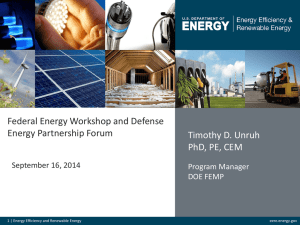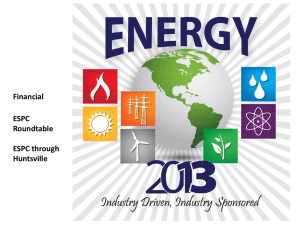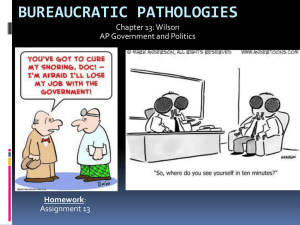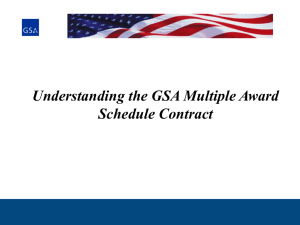ESPC Challenge
advertisement
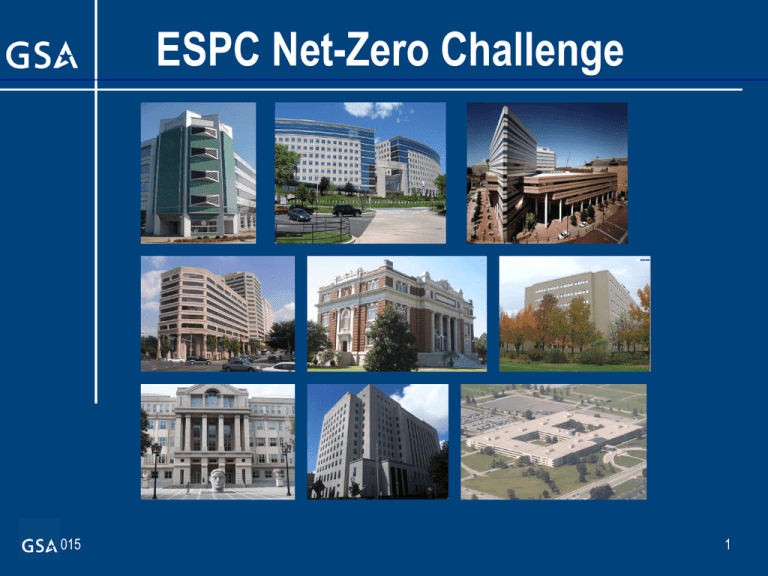
ESPC Net-Zero Challenge 4/8/2015 1 Overview • President’s Performance Contract Challenge • Background on GSA • Energy Mandates • American Recovery and Reinvestment Act • Deep Retrofits • GSA ESPC Net Zero Renovation Challenge • What’s Next? 4/8/2015 2 Progress Targets & Milestone Targets • To track Agency progress, CEQ/FEMP has developed Milestone Targets and Progress Targets – Milestone Targets are major project development milestones. If an agency fails to get 100% of its total project investment by the milestone target date, a “ ” is earned on its Progress Report. – Progress Targets track agency progress: if an agency’s project investment amount is not 25, 50, or 75 percent of its Milestone Target by the prescribed dates, it earns a “ ”. Development Stages Commitment Met 75 100 Agency Plans made 50 75 75 100 NOO Released 50 75 75 75 100 Service Provider Selected 25 25 50 50 50 75 75 75 100 Milestone Targets NOITA Issued 0 25 25 25 50 50 50 75 75 75 100 IGA Submitted 0 0 0 0 25 25 25 50 50 50 75 75 75 100 Awarded 0 0 0 0 0 0 0 0 25 25 25 50 50 50 75 75 75 100 15-Dec 15-Nov 15-Oct 15-Sep 15-Aug 15-Jul 15-Jun 15-May 15-Apr 15-Mar 15-Feb 15-Jan 15-Dec 15-Nov 15-Oct 15-Sep 2013 15-Aug 15-Jul 15-Jun 15-May Target Dates → 15-Apr 2012 Total agency project investment should equal 100% of its commitment in the Development Stage at the Milestone Target Date. To demonstrate adequate progress, 25%, 50%, and 75% of the agency's total project investment should be attained by the prescribed dates. Progress Targets 4/8/2015 3 Explanation of Progress Report Agency Progress Report As of May 15, 2012, only one Milestone has been reached. The next is due July 15, 2012 Agency: Progress toward the investment of $2 billion by December 31, 2013 Agency A Commitment: $95,000,000 Milestone Targets occur when 100% of committed project investment is at a milestone stage by the due date Source Date: May 15, 2012 Est. Investment % of Value (millions Commitment USD) Target Milestones Target (As of 5/15/12) Score Comments Project Initiation Agency has identified projects with investment values equal to or above its commitment by May 15, 2012 84.96 89% 100% 71.35 75% 75% 56.35 59% 75% 51.35 54% 25% 48.50 51% 25% 22.50 24% 0% 7.40 8% 0% Project investment total below commitment. An agency will earn a red dot if they miss a Milestone Target Planning Agency has developed acquisition plans and target dates by July 15, 2012 Notice Of Opportunity Agency has released all Notices of Opportunity by August 15, 2012 Vendor Selection Project Development Milestones Agency has selected service providers by December 15, 2012 Intent to Award Agency has issued Notices of Intent to Award by February 15, 2013 Facility Audit Agency has received an Investment Grade Audit Award Agency has awarded project Legend: 4/8/2015 Meeting all target metrics Below 25%, 50% or 75% Progress Targets Missed Milestone Target No target metric at this stage Project Investment by Contract Vehicle Agency A Investment Distribution Across Stages $30 $25 Project Investment (milions) This chart shows the distribution of the agency’s current project investment among project development stages as reported in OMB Max. “No start/no data” is the amount of project investment either not started or lacking data. A grey dot indicates no Milestone or Progress Targets are due. $20 Investment Gap $15 DOE ESPC $10 ACOE ESPC UESC $5 Other $0 No start/No data Acquisition Plan Done Released NOO ESCO Selected PA developed NOITA Issued IGA Final Prop. Submitted Submitted Awarded Progress Targets measure total committed in progressively higher 25%, 50%, and 75% levels as the due date approaches An agency will earn a yellow dot if they miss a Progress Target This chart breaks down total project investment by contract vehicle used. The “Investment Gap” is the difference between agency commitment and total current project investment. 4 Resources • FEMP • GSA • Resources available to each of your sites: FFS, PFs, GFO contracting mentors, contracting support from DLA, Huntsville, private contractors. Extensive training and technical information on the web. • An extensive ESCO network . 4/8/2015 5 Program Options: A new option for many small sites • Most large and medium sites will be well served through the standard ESPC and UESC offerings. • Small sites should explore FEMP’s newest program option: ESPC ENABLE. • Pilot program designed to make projects at small sites cost effective for agencies and ESCOs. • Projects will be executed through GSA Schedule 84, using a new set of automated and standardized tools and contract templates. • FEMP has identified five agencies to partner with to establish agency specific approaches to 4/8/2015 6 implementing ESPC ENABLE projects. Near Term Deliverables • May 15: $ Projects ≥ $ Commitment? • July 15: Acquisition Plans Complete; Projects’ Timelines Established • August 15: Notices of Opportunities Issued • Federal Environmental Executive will follow up with agencies not meeting these milestones to identify strategies /actions to meet the milestones. 4/8/2015 7 Background on GSA GSA consists of: Public Buildings Service (PBS) Federal Acquisition Service (FAS) Office of Governmentwide Policy (OGP) other staff offices 9,624 buildings in 11 regions 1,530 owned and 8,094 leased (2010) 370.2 million rentable square feet, or 34.4 million square meters Landlord for 400 federal agencies, bureaus and commissions with space for over 1,000,000 tenants 4/8/2015 8 GSA Energy Profile • Currently represents 9.3% of civilian agency energy usage, 3.7% of Federal total • Has achieved ~16% in energy reduction from 2003 baseline Federal Agency Percent Reduction in Btu/Sq.Ft. 2003-2010 GSA 16.1% per FY10 OMB Scorecard (source: FY2010 OMB Scorecard on Sustainability/Energy) 2015 mandate -20% -15% -10% -5% 0% 5% 10% 15% 20% 25% 30% 35% 40% GSA Office of Federal High Performance Green Buildings Players Influences Research Adoption Relationships Roles 4/8/2015 10 Sustainability & Regulations Laws ▪ National Environmental Policy Act, 1969 ▪ Clean Air Act, 1970; amended 1990 ▪ Energy Policy and Conservation Act, 1975 ▪ Resource Conservation & Recovery Act, 1976; amended 1994 ▪ National Energy Conservation Policy Act, 1978 ▪ Energy Policy Acts, 1992, 2005 ▪ Energy Independence and Security Act, 2007 Executive Orders ▪ 13101 Greening the Government through Waste Prevention, Recycling & Federal Acquisition ▪ 13123 Greening the Government through Efficient Energy Management ▪ 13134 Developing & Promoting Biobased Products and BioEnergy ▪ 13148 Greening the Government through Leadership in Environmental Management ▪ 13327 Federal Real Property Asset Management ▪ 13423 Strengthening Federal Environmental, Energy, and Transportation Management ▪ 13514 Federal Leadership in Environmental, Energy, and Economic Performance 4/8/2015 11 American Recovery and Reinvestment Act (ARRA) Recovery Act Portfolio Energy Use Reduction • The combined Recovery Act portfolio of Major Modernization and Limited Scope projects will be 30% more energy efficient than the CBECS2 national average. • Recovery Act projects are expected to reduce energy consumption by 18% across 447 buildings (for Major Modernization, Limited Scope, and Small Projects). • Average annual cost savings is an estimated $44.4M per year. 2 Commercial Building Energy Consumption Survey (CBECS) national average energy intensity = 90 kBtu/sq. ft PBS 2003 and 2009 baseline energy intensity on Recovery Act projects from GSA's Energy Usage Analysis System (EUAS) 13 Recovery Act Deep Retrofits A deep retrofit is a modernization that is anticipated to achieve an energy reduction of at least 50%. Of the 45 Recovery Act modernization projects, six are anticipated to reduce overall energy consumption by at least 50%. Five of the deep retrofits are projected to reduce overall energy consumption from 53%-68%. Five of the deep retrofit modernizations are utilizing renewable energy technologies to reduce overall energy consumption. An additional twelve limited scope and modernization projects anticipate achieving an energy reduction between 40% and 50%. All Recovery Act buildings undergoing Major Modernization projects are expected to achieve enough gains in energy efficiency to meet EISA 2007 requirements. Recovery Act Case Study • • • • Net-zero energy target Platinum LEED rating goal Historic Building 123 kW PV array to produce 170,000 kWh a year (greater than 50% of the building’s historical annual electricity use) • Ground source heat pumps • ECMs: lighting control and monitoring, demand controlled CO, Grand Junction Wayne N. Aspinall Federal Building & US ventilation, plug load management measures, Courthouse thermally improved building envelope. • Building physics analysis used Approach to Net Zero Recommended Approach Reduce Demand 4/8/2015 On Site Renewables Net Zero Source: RMI 16 “Deep Energy” Retrofit • Process Differentiators – Building Owner Involvement – Integrative Design – Advanced Auditing, Modelling, LCCA – Ongoing M&V – Occupant Engagement • Results: – Larger Energy Savings – Improved Project Economics 4/8/2015 17 17 SAVINGS IN EXCESS SERVICE PAYMENTS PAYMENTS TO FINANCING INSTITUTION PAYMENTS TO UTILITY PROVIDERS GUARANTEED PORTION PAYMENTS TO UTILITY PROVIDERS AFTER PERFORMANCE CONTRACT BEFORE PERFORMANCE CONTRACT Energy Savings Performance Contract (ESPC) Zero or positive net impact on existing budgets. 4/8/2015 18 Timing is Key to Profitable Deep Retrofits • • • • • 4/8/2015 Planned Capital Improvement Major Occupancy Change Major System Replacement Upgrades to Meet Code Fixing an “Energy Hog” 19 GSA Use of ESPCs • $440M invested in ESPC since $250 1999 GSA ESPC Investment (DOE IDIQ) ($M) 1 $200 • Renewed GSA $150 $100 interest and $50 $0 investment in ESPC ($262M in FY10-11) 3 0 1 5 6 7 7 0 2 2 1 1 1 GSA proposes to employ a Net Zero ESPC Challenge as a tool to further accelerate the use of ESPC’s by the GSA regions in addressing energy reduction goals 4/8/2015 20 ECMs in ESPCs 4/8/2015 21 Background • October 20, 2011 Administrator Johnson’s Announcement: GSA Challenges Private Sector to Reduce Energy Use at Federal Buildings • October 27-28, 2011 ESPC Charrette • December 2, 2012 Presidential Memorandum 4/8/2015 – $2 billion in performance-based contracts within 24 months – Report planned implementation schedule by 1/31/2012 – Issue NOO in March, 2012 22 GSA Challenge Goals • Demonstrate best practices for maximizing overall ESPC project energy savings; • Advance progress toward EISA goals; • Accelerate deployment of underutilized and renewable technologies; • Further expose GSA regions to DOE ESPC IDIQ contract process and resulting improvements in ESCO selection; • Identify and understand processes necessary to get to net zero energy; • Identify structural, contractual and technical impediments. 4/8/2015 23 GSA Challenge Framework • Site Selection: GSA selected 30-35 buildings for competition across multiple regions • Award Process: Buildings to be awarded with DOE’s streamlined competition process • Recognition: Projects to be evaluated by a panel of independent experts to identify and recognize exceptional performance in a number of technical categories 1. absolute energy savings of pre-retrofit energy use 2. progress towards Federal Government goals for energy, water, fossil fuel, renewable energy, and sustainability 3. financial and technical creativity 4. ability to extend best practices to other Federal buildings. 4/8/2015 24 ESPC Charrette 1. Analysis and Integrated Design 2. Project Economics 3. Delivery Process 4. Occupant Behavior 5. M & V 4/8/2015 25 Analysis and Integrated Design Deep savings may not be cost effective over contract term Lack of information on existing buildings Typical ESPC process looks at individual ECMs High risk to guarantee deep savings 4/8/2015 26 1. Analysis and Integrated Design Barriers Solution 1. Deep savings may not be cost effective over contract term (No $ available from agencies) Identify funds available through coordination between energy managers, master planning and capital improvement Find solutions to channel saved space into funding for Deep Retrofits Bulk purchasing Phased implementation of ECMs 2. Lack of info on existing buildings (metered/utility data) GSA needs to store and categorize reports/data into centralized searchable database 3. Typical ESPC process looks at individual ECMs Process needs to value bundles of integrated measures 4. Laws tell you to save energy, ESPC process demands $ savings Disconnect must be reconciled 5. High risk to guarantee deep savings (ability to model new technologies) 6. No way to take credit for ‘other’ savings (O&M, increased productivity, etc.) 4/8/2015 ESCO engineers have experience and judgment needed Tools need to keep up with new technologies GSA needs to develop a standard way to assign value for these things 27 Project Economics High financing costs Integration with planned improvement projects Inclusion of avoided future costs in ESPC including capital and maintenance Contract duration limits longer payback measures 4/8/2015 28 ESPC Delivery Process Months 1 2 3 4 5 6 7 8 9 1 0 1 1 1 2 Best-Expedited Schedule 28 days Project planning (28-63 days) Work w/FFS Form Acq. Team Request PF 132 days 15 TO-RFP (15-35 days) Prelim. Assessment — ESCO selection (132-246 days) Notice of Opp. Select ESCO Evaluate PA Send NOIA 12.1 mos. 14 30 45 days days Site/Agency Final Review Reviews, (30 days) Negotiations, GFO and Award Review(45-55 days) (14 days) 105 days IGA & Final Proposal (105 – 150 days) Longer Schedule 63 days Project planning 150 days IGA & Final Proposal 1 1 3 4 Months 1 5 246 days PA – ESCO selection 35 TO-RFP IGA & FP 19.5 30 1 55 days mos. Site/Agency GFO days 4 Final nego’s & award Review 1 6 1 7 1 8 1 9 2 0 2 1 2 2 2 3 Source: DOE/FEMP 2 4 29 Occupant Behavior Difficult to quantify energy/cost savings Limited good examples of “Behavior ECMs” Hard to incentivize all occupants ESCOs have no control over occupants 4/8/2015 30 Measurement & Verification • Uncertainty/variability of how building is operated after installation • Cost, level of effort, and complexity for whole building M&V • Consistency across GSA offices, agencies and regions • Improved baseline performance data 4/8/2015 31 Additional Improvement Opportunities • Improve the ESPC award and M&V process • Treat O&M as ECM and have ESCO provide that service • Allow avoided future replacement costs • Share risk • Accept occupant behavior energy use reduction • Support multi-building projects • Improve building energy data base lining • Renegotiate FEMP contract terms 4/8/2015 32 High Priority Solutions • • • • • • 4/8/2015 Reduce time to contract award Redefine eligible savings Share risk Combine funding Multi-building projects, bundling Consider occupant behavior programs 33 ESPC Challenge Buildings • 30-35 Buildings • 18 million sqft • 100,000 – 800,000 sqft • $150-250 million potential project size • $7 million annual savings potential And The Elephant in the Room We Need To Use Less: Square Feet E X A M P L E: A R R A P R O J E C T Broad Range of Opportunities and Challenges - 1975 Federal Building - Never Upgraded Plan: - Updating Cutting Edge ‘Green’ Design - $133 M from Recovery Act - Full Building Modernization - High Aims for Sustainability and Curb Appeal - Construction procurement underway Portland, OR EGWW—Shading Reed Construction THE EXTREME CHALLENGE Broad Range of Opportunities and Challenges - Historic 1917 Building - Last Upgraded in 1935 Plan: - Modernization with Infill - $161 M from Recovery Act, as Phase I - Must Redesign for Energy Goals Washington, D.C. Renderings What’s Really Happening in the Office? Autur and Murmane, 2003 Questions? Kinga Porst kinga.porst@gsa.gov Kevin Kampschroer kevin.kampschroer@gsa.gov Sharon Conger sharon.conger@gsa.gov FEMP: Dr. Timothy Unruh Timothy.Unruh@ee.doe.gov 4/8/2015 41 41
